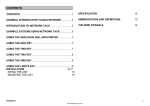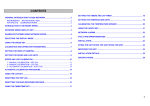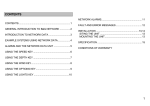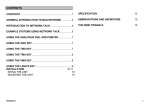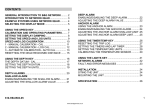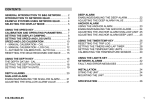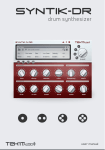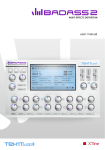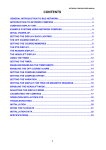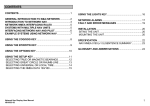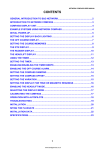Download Network Wind User Manual
Transcript
CONTENTS CONTENTS 1 GENERAL INTRODUCTION TO B&G NETWORK 2 SITING THE UNIT 14 INTRODUCTION TO NETWORK WIND 3 MOUNTING THE UNIT 14 EXAMPLE SYSTEMS USING NETWORK WIND 4 SPECIFICATION 16 SELECTING THE DISPLAY MODE 5 ABBREVIATIONS AND DEFINITIONS 17 THE ANALOGUE DIAL AND POINTER 6 THE WIND TRIANGLE 17 USING THE APP. KEY 6 CONDITIONS OF WARRANTY USING THE TRUE KEY 7 USING THE VOLTS KEY 7 USING THE SETUP KEY 8 SETTING THE DIGITAL DISPLAY DAMPING 9 SETTING THE ANALOGUE DISPLAY DAMPING 10 WIND SENSOR ALIGNMENT 11 ADJUSTING THE WIND SENSOR OFFSET 12 USING THE LIGHTS KEY HB-0502-03 INSTALLATION 14 13 1 GENERAL INTRODUCTION TO B&G NETWORK The B&G Network range of instruments is designed to be used as individual units or connected together to form an integrated navigational system. A single network cable is used to carry data and power between units. The latest technology and screened cables throughout the Network System ensure the ultimate protection from interference between units and other systems. All Network instruments can be linked to Network PILOT, Network CHART, Network GPS or Network LORAN receivers or via NMEA 0183 (v1.5) to other navigational equipment. INSTRUMENTS NAVIGATIONAL AIDS Network SPEED Network DEPTH Network QUAD Network WIND Network TACK Network DATA Network GPS Network LORAN Network NAV Network CHART AUTOPILOTS COMMUNICATIONS Network PILOT Network VHF HB-0502-03 2 INTRODUCTION TO NETWORK WIND NETWORK WIND DISPLAY UNIT The Network WIND unit measures and displays wind 0 information on an analogue 360 Apparent Wind Angle meter and a back-lit Liquid Crystal Display (LCD). The five keys allow selection of the information displayed on the LCD and setting of the units mode, Wind Sensor offset calibration and display damping. It can operate as the main Network WIND unit either alone or as part of an Intregrated Network Instrument System taking inputs directly from a Wind Sensor which plugs into the socket at the rear of the display, or as a repeater of wind information received via the two Network cable tails. For true wind functions Network WIND must be connected to a system that contains a Network SPEED or Network QUAD unit as boat speed is required. The unit is able to transmit NMEA 0183 v1.5 data via the network cables to other Network units and connect to an NMEA device e.g. a position fixer, with a special NMEA output cable. The unit has no internal alarm or alarm functions. IMPORTANT NOTE Your Network WIND unit must be setup and calibrated correctly before it is used as part of a navigational system. HB-0502-03 3 EXAMPLES SYSTEMS USING NETWORK WIND Only one Network WIND unit should have a wind sensor connected to it and set to transducer mode. Up to three more Network WIND units can be connected on to the system network, these must be set to repeater mode. See SELECTING THE DISPLAY MODE. For True wind functions the Network WIND must be part of a system containing Network SPEED or Network QUAD. QUAD Wind Sensor QUAD WIND Master Unit Network SPEED, Network DEPTH, Network WIND and Network TACK (magnified wind angle). WIND Repeater WIND TACK WIND Repeater The Network units can be connected together in any order as data is shared via the system network cable link. Depth HB-0502-03 Speed 4 SELECTING THE DISPLAY MODE The Network WIND unit has three operating modes. The correct mode must be selected for your Network system to operate correctly. tu Unit mode, the unit uses and displays wind data from a wind sensor connected directly into the display unit. Your unit is supplied in this mode. tr Repeater mode, the unit operates as a wind repeater using data from the system network. td Demo mode, the unit runs an internal demonstration program. Press SETUP key 4 times to display current mode. HB-0502-03 Press ENTER key if the mode needs to be changed. The display flashes. Use ¿ or À key to change the mode. Press ENTER key to memorise the new mode. After 30 secs the display will revert to previously selected display. 5 THE ANALOGUE DIAL AND POINTER USING THE APP. KEY The analogue pointer always indicates Apparent Wind Angle 0 0 on the 360 dial. Each division marker is at 30 intervals. The LCD is offset to the left so when running with the wind astern the wind angle can still be read clearly. Press the APP. key to display Apparent Wind Speed on the LCD. The LCD APP legend will be displayed. HB-0502-03 6 USING THE TRUE KEY USING THE VOLTS KEY Press the TRUE key to display True Wind Speed on the LCD. The LCD TRUE legend will be displayed. If boat speed data is not available the LCD digits will be blank and the TRUE legend will be displayed. Press the VOLTS key to display Battery Volts on the LCD. The LCD V legend will be displayed. HB-0502-03 7 USING THE SETUP KEY Press the SETUP key to cycle through the following options on the LCD. dS Damping Speed, this is the response time of the LCD wind speed display. dA Damping Analogue, this is the response time of the analogue pointer. OF Offset, this is the offset calibration value to correct for Wind Sensor misalignment. tu Display mode, this is the operating mode of the Network WIND unit. HB-0502-03 8 LCD WIND SPEED DAMPING The wind speed damping allows the response time of the LCD wind speed display to be slowed down if the values are to jumpy in gusty conditions. The damping works by averaging the wind speed over a set time period, the longer the time period the smoother the displayed values, however the longer it takes to see any change. Network WIND allows selection of four damping values, d1, d2, d4, d8, each is the approximate time in seconds. The unit is supplied with a factory set value of d4. HB-0502-03 9 Press SETUP key once to display dS, damping Speed. HB-0502-03 Press ENTER key to display current damping speed. The display flashes. Use ¿ or À key to cycle through the damping values. Press ENTER key to memorise the new value. After 30 secs the display will revert to previously selected display. 10 ANALOGUE POINTER DAMPING The analogue pointer damping allows the response time of the analogue display to be slowed down if the values are to jumpy in gusty conditions. The damping works by averaging the wind angle over a set time period, the longer the time period the smoother the displayed values, however the longer it takes to see any change. Network WIND allows selection of four damping values, d1, d2, d4, d8, each is the approximate time in seconds. The unit is supplied with a factory set value of d1. Press SETUP key twice to display dA, damping Analogue. HB-0502-03 Press ENTER key to display current damping speed. The display flashes. Use ¿ or À key to cycle through the damping values. Press ENTER key to memorise the new value. After 30 secs the display will revert to previously selected display. 11 WIND SENSOR MISALIGNMENT CORRECTION For accurate wind angle readings the wind sensor should be pointing forward and aligned with the centreline of the boat. However, this is not always possible, so Network WIND allows a wind sensor offset value to be entered to compensate for the misalignment electronically. Firstly the amount of misalignment must be found. The following procedure will enable you, during the course of a sea trial, to establish the value. 3 Determine the direction of the misalignment and wind sensor offset value by subtracting the Starboard value from the Port value, then dividing by two. e.g. Port 35 - Starboard 25 = 10 ÷ 2 = 5. If the value is positive the misalignment is to Port, if the value is negative it is to Starboard. 4 Enter the wind sensor offset value into the Network WIND unit's memory by following the procedure below. 1 Sail close-hauled on a Port Tack, note the set of all the sails. When the conditions are steady, note the apparent wind angle 0 (AWA) on the analogue display, e.g. Port 35 . 5 The alignment procedure should be repeated until the displayed AWA is equal on both tacks. NOTE: If you have Network TACK or Network DATA the AWA can also be read from these. 2 Turn the boat until close-hauled on a Starboard Tack, make sure the sails are set as for the Port Tack. When the conditions are steady, note the AWA on this 0 e.g. 25 . HB-0502-03 tack, 12 ADJUSTING THE WIND SENSOR OFFSET If the value calculated is positive, the wind sensor is misaligned to Port. To correct this the analogue pointer must be offset clockwise (towards starboard) by the value calculated. Use the ¿ key (up) to change the value displayed on the LCD. If the value is negative, the wind sensor is misaligned to Starboard. To correct this the analogue pointer must be offset anti-clockwise (to port) by the value calculated. Use the À key (down) to change the value displayed on the LCD. Press SETUP key 3 times to display OF, OFfset value. HB-0502-03 Press ENTER key to display current value. The display flashes. Factory set to zero. Use ¿ or À key to adjust the value. ¿ = clockwise À = anti-clockwise. Press ENTER key to memorise the new value. After 30 secs the display will revert to previously selected display. 13 USING THE LIGHTS KEY The Network WIND Display unit has 3 levels of illumination and off, controlled by the LIGHTS key. The level selected is for the whole Network system. • • • • L0 L3 L2 L1 OFF High Medium Low The LIGHTS key also changes the illumination level of the key legends, it always remains illuminated so even in complete darkness the key can be located. HB-0502-03 14 INSTALLATION MOUNTING THE UNIT The display heads are supplied with a clip-in mounting bracket which allows for easy installation, access from behind is not necessary to secure the unit in place. However to prevent theft and permanently fix the unit in position, locking studs and thumb nuts are supplied. Use the cutting template supplied to mark the centres of the holes for the self-tapping screw, the fixing stud holes and the mounting bracket. SITING THE UNIT All Network Instruments are designed for mounting on or below deck. A mounting position should be selected where they are: • Easy to read by the helmsman • On a smooth and flat surface • At least 100mm (4") from a compass • Accessible from behind for fitting locking studs if required. HB-0502-03 • The template allows 4mm (5/32") between adjacent units for the suncover, increase this distance if required to maximum of 60mm (2 3/8") between units or 180mm (3 1/8") between centres. For greater distances between units extension cables are available. • Use a 70mm (2 3/4") diameter hole-cutter for the mounting bracket hole. • Use a 2.9mm for the self-tapping screw holes. • Use a 5mm (3/32") drill for the locking stud holes. • Secure the mounting bracket to the bulkhead with the self-tapping screws supplied • Fit the rubber sealing gasket around the mounting bracket. • Screw the locking studs into the back of the display head (if required). • Carefully pass the cable tails through the mounting bracket hole, connect the cables to the main units. • Clip the display head into the mounting bracket. • Secure the instrument with the thumb nuts supplied. 15 INSTALLATION HB-0502-03 16 SPECIFICATION PHYSICAL PARAMETERS ELECTRICAL Construction Window Display Power Supply Operating Current Protection Dimensions Weight High impact ABS plastic Acrylic Analogue dial and pointer Back-lit Liquid Crystal Display: Digits: 12mm 0.47" 110 x 110 x 25.4mm 4 x 4 x 1" Requires 65mm 2.6" depth behind bulkhead for display barrel. 0.3 kg 0.66lbs ENVIRONMENTAL Operating Temp Storage Temp Humidity 0 -10 to +55 C @ 93%RH 0 +14 to +131 F @ 93%RH 0 -25 to +70 C @ 95%RH 0 -13 to +158 F @ 93%RH Up to 95%RH Sealing Fully sealed front, suitable for bulkhead cockpit mounting. Vented barrel to prevent condensation. HB-0502-03 12V DC nominal (10 to 16V) 40mA typical, 100mA illuminated Connect via external 5A fuse or circuit breaker. CABLES AND CONNECTIONS Connection to adjacent units is via cable tails fitted with either a plug or a socket. Extension cables are available from your dealer. The cable tails carry power and NMEA data between units. ALARM There is no internal audible alarm NMEA OUTPUT SENTENCES $IIHDM $IIVHW $IIDBT $IIVWR $IIMTW Heading Speed and Heading Depth Apparent wind angle and speed Sea temperature 17 ABBREVIATIONS AND DEFINITIONS THE WIND TRIANGLE AWA Apparent Wind Angle - The angle between the boat's bow and the wind blowing across the deck (at mast height). AWS Apparent Wind Speed - The wind speed across the deck (at mast height). TWA True Wind Angle - The wind angle between the boat's heading and the true wind (at mast height). This is calculated from AWA, AWS and boat speed. This is the wind relative to the water, not the land. TWS True Wind Speed - The wind speed over the water, independent of the boat's motion through it. Calculated from AWA, AWS and boat speed. VMG Velocity Made Good - A measure of performance upwind or downwind calculated from TWA and boat speed. HB-0502-03 18


















